1
The settlers who colonized New France used the word "porpoise" to designate several types of whales, specifically the beluga (Delphinapterus leucas). The name "beluga" is derived from "bièluï," which means "white" in Russian. This marine mammal is also called "white whale," "white porpoise" and "sea canary," because of its songs.The beluga lived in the Champlain Sea for more than 10,000 years. As the sea receded, it left behind the St. Lawrence River, and the pods of belugas were separated between the Arctic and the St. Lawrence.
The Inuit were the first to hunt the beluga and they continue to hunt it to this day for its flesh, blubber, skin and bones. The pods of belugas in the circumpolar region differ from those in the St. Lawrence River: those in the St. Lawrence never migrate out of the estuary and the Gulf of St. Lawrence.
Jacques Cartier was the first to describe belugas on his second voyage to Canada in 1535. He said that they were "as white as snow and without any marks; and there are many of them in the river that live between the sea and fresh water. The natives (Iroquoian from Stadaconé) call them 'adhothuys' and told us that they are very tasty."
In the first quarter of the 16th century, the Basques came to fish in the river's estuary and along the coast of the north shore. They hunted whale and beluga for their blubber, which they made into oil. Throughout the 18th century, the Basques came in increasing numbers to the Gaspé Peninsula coast in summer. They shared their fishing know-how with the settlers. On his first voyage, Samuel de Champlain met Basque fishermen, and drew from their knowledge of the north shore of the St. Lawrence River. Lescarbot and Champlain described the main Basque colony of Lesquemin, now called "Les Escoumins."
Father Gabriel Sagard, a Récollet, wrote about his Great Voyage to the land of the Hurons, during his stay in New France and with the Hurons from August 1623 to July 1624. He wrote that when they reached Canadian waters, the seamen hunted beluga for a change in their diet: "Our seamen harpooned a large female porpoise with a baby porpoise inside her, which was larded and roasted like a leveret, then eaten, along with the female, which kept us fed for several days; it was a great treat, since we were tired of salt meat and fish, the standard fare eaten at sea."
2
Inuit fishing belugas1995
Nunavik Territory, Canada
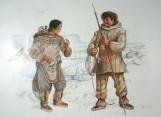 Credits:
Credits:Frédéric Back
Quebec Inuit
Dry pastel and gouache on frosted acetate Letraset paper
3
Inuit sculpture - Beluga1948
Payne Bay, Kangirsuk, Nunavik, Canada
 Credits:
Credits:Sculptor unknown
Soapstone
Photograph: Judith Douville
4
Inuit sculpture - Man riding a belugaAround 1940
Puvirnituq, Nunavik, Canada
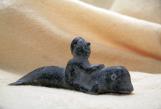 Credits:
Credits:Joe Talirulini (born circa 1893?1976), Soapstone Sculpture
Photograph: Judith Douville
5
Inuit sculpture - Pod of belugasBetween 1940 and 1955
Nunavik Territory, Canada
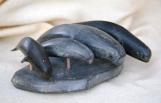 Credits:
Credits:Sculptor unknown
Soapstone
Photograph: Judith Douville
6
Basque fisherman17th and 18th centuries
St. Lawrence River, Lower North Shore, Quebec, Canada
 Credits:
Credits:Illustration: author unknown
7
Beluga fishing plan, previously the property of the Collège de Sainte-Anne-de-la-Pocatière25 November 1884
Cap Martin, Sainte-Anne-de-la-Pocatière, Quebec, Canada
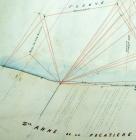 Credits:
Credits:Centre d'archives de la Côte-du-Sud
Collège de Sainte-Anne-de-la-Pocatière collection
Drawing by M. Richard, surveyor, China ink and watercolour on white cardboard
Photograph: Judith Douville
8
About 50 years after Sagard's voyage, Jean-Baptiste Deschamps de La Bouteillerie, sieur of Boishébert, left Dieppe for Quebec at the end of June 1671 on the Saint-Jean-Baptiste, with two carpenters, two masons, and four labourers. He went to occupy the seigneury promised by the King of France, Louis XIV, which was finally granted to him on October 29, 1672. His land was along the edge of the St. Lawrence River, at Rivière-Ouelle, where beluga fishing truly gained significance.In 1698, seigneur Deschamps and Charles Denis de Vitré made their first beluga fishing attempts. They set up the fishery between the Kamouraska Islands and in Rivière-Ouelle. The results were encouraging, especially in Rivière-Ouelle. In 1701, three merchants from Québec City, Vitré, Hazeur and Peire, obtained permission from Louis XIV to fish for beluga. They created a company, which did not include any settlers. We do not know much about the performance of this company. However, we do know that the inhabitants of Rivière-Ouelle reclaimed the right to fish on their shore fronts. It was not until 1705 that settlers could actively participate in beluga fishing. On July 20, 1707, the first official beluga fishing concession was granted by Intendant Raudot to six inhabitants of Rivière-Ouelle. The merchants were not excluded; since they also had rights and privileges, they continued to participate in the fishery. The settlers also needed them to sell beluga by-products.
From then on, a number of fisheries were started along the coast between Sainte-Anne-de-la-Pocatière and Kamouraska. One of these fisheries, at Cap Martin, Grande-Anse, was built in 1716 and is very well documented. The Collège de Sainte-Anne-de-La-Pocatière would later become one of its owners.
The numerous fisheries only succeeded in spreading out the catches between fishermen. Disputes resulted. The fisheries did not do as well as the administrators had hoped. There was significant and instructive correspondence between operators, intendants and the King of France.
Finally, only the fishery in Pointe de la Rivière Ouelle remained, possibly because of its proximity to the river. At the river's mouth are many sandbanks where capelin spawn; belugas feed on capelin. This fishery stood the test of time and its shares were subdivided endlessly between the shareholders' many heirs.
Then, on November 9, 1870, the co-owners of the land incorporated the "Compagnie de la Pêche aux marsouins de Rivière-Ouelle." Its share capital was made up of 7,200 shares divided six ways. Each share was equal to one pole. The beluga fishery lasted for 40 years in this manner.
The beluga fishery was the first commercial fishery in New France. It may have encouraged people to settle in Rivière-Ouelle. Moreover, life was said to be a little easier for the first inhabitants, who had the opportunity to farm the land and to fish. This is clearly illustrated on the Town of Rivière-Ouelle's coat of arms.
9
Map of the north and south shores of the St. Lawrence, showing Pointe de la Rivière Ouelle24 September 1961
Parts of the north and south shores of the St. Lawrence River, Quebec, Canada
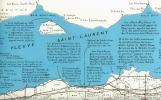 Credits:
Credits:Adrien Caron, priest
Map: History of the land and parishes of the Côte-du-Sud, 1961
New edition: Société historique de la Côte-du-Sud, 1982
10
Town of Rivière-Ouelle coat of arms20th century
Rivière-Ouelle, Quebec, Canada
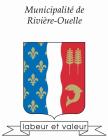 Credits:
Credits:Town of Rivière-Ouelle
11
Early 18th-century sketch of a beluga fishery at Pointe de la Rivière OuelleEarly 18th century
Pointe de la Rivière Ouelle, Rivière-Ouelle, Quebec, Canada
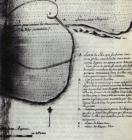 Credits:
Credits:BAnQ 03Q, E1, S1, P839
12
Operating permit and concession to fish beluga, signed by Intendant Raudot20 July 1707
Québec City, Quebec, Canada
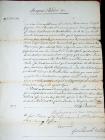 Credits:
Credits:Intendant Jacques Raudot
Photograph: Guy Duguay
13
Account by Boishébert citing reasons for the poor beluga fishing results1726
Rivière-Ouelle, Quebec, Canada
 Credits:
Credits:BAnQ MIKAN no. 3066132
Set C11A (R11577-4-2F)
14
Summary of a letter from Philippe Peire on beluga fishing18th century, 1730
Rivière-Ouelle, Quebec, Canada
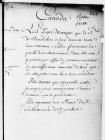 Credits:
Credits:BAnQ MIKAN no. 3050612
Set C11A (R11577-4-2F)